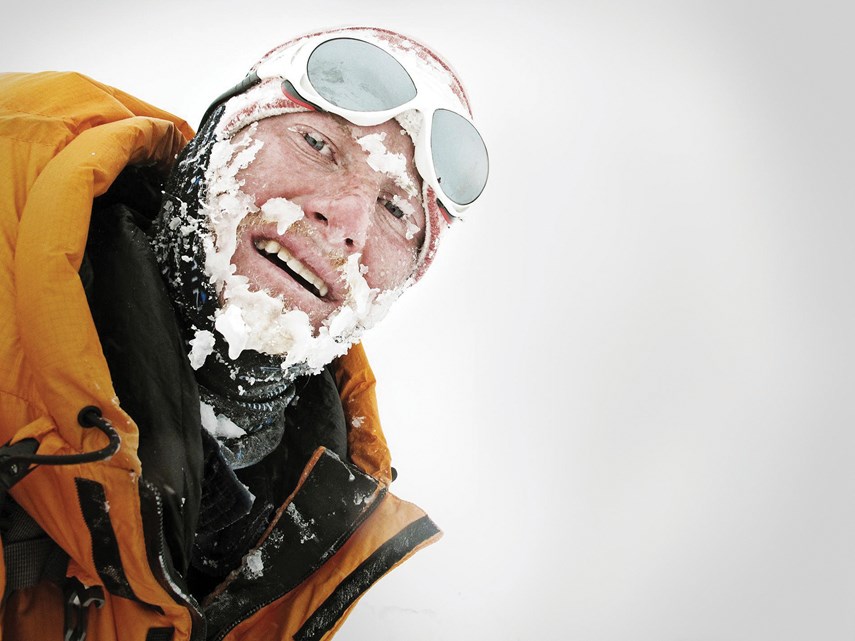Cory Richards speaks tonight at the Â鶹´«Ă˝Ół»International Mountain Film Festival, Centennial Theatre, North Vancouver. Doors 6:30 p.m., show 7:30 p.m. For more information visit .
Watching snowflakes slip past a frosted window in Bozeman, Montana, Cory Richards meditates on the world that’s out there and the world that’s in.
Yes, he’s a climber and yes, he’ll be doing a talk. That doesn’t mean the talk is about climbing.
“If they only want to see a climbing show . . . they might be a little disappointed,” he says with a chuckle.
Richards’ struggles with post-traumatic stress disorder and alcoholism are intertwined with his tales of scaling those few mountain peaks that seem to rip a hole in the cloudbanks that rest on the planet’s roof.
Richards’ most famous photo, the one he once called a “f@//ing selfie,” was taken after an avalanche. He was on Gasherbrum II, a 26,360-foot peak in the northern reaches of Pakistan. He and two friends were planning to be the first to stand on that summit in winter.
Getting to the top was hard. Getting back down nearly killed them.
Other mountaineers who chased that peak learned the same lesson Napoleon learned about attacking Russia: don’t do it in winter.
But the trio’s midwinter bid was successful. It wasn’t until they were in the midst of their descent that the snowbank shifted and tumbled.
In a piece written for National Geographic, Richards remembers one of his friends asking if everything was OK. He asked just after the avalanche hit.
“Dude, everything is not OK,” Richards replied.
A lily-white infestation of ice sprouted from his beard. His face was that shade of red that shocks the barroom mirror when the lights come up for closing time. And in the lens of his sunglasses you can see the reflection of the mountain’s peak where he’d triumphed moments earlier.
He snapped the selfie that would eventually grace the cover of National Geographic.
Growing up in Salt Lake City, Utah, Richards was classified as “gifted;” a designation he’s uneasy with today.
“I’m not sure how much I approve,” he says, speaking slowly enough to choose his words with care.
He started high school two years early but didn’t stay for long.
Richards was reluctant to discuss details over the phone, only saying there were a “whole series of events” that led to him leaving school.
“When you’re 12 and you’re surrounded by 18-year-olds, it can be, I think, a little bit socially overwhelming.”
Unmoored from what his life had been, Richards headed for mountains.
He was probably looking for internal value with external accomplishments, he says. But, as Teddy Roosevelt once said, “all Americans” like big things, and Richards was no different.
“I’ve always just been inspired by very big places. They excite me.”
Desert plains, mountain ranges and the ocean aren’t scenery to conquer but common touchstones that reveal who we are.
“They put us in our place,” he says. “The more I engage with those places I think the closer I come to having some clarity on my own place in this world.”
Richards has immortalized a polar bear lumbering over the last heap of snow on the rocky climes of Rudolf Island on the lip of the Arctic Ocean. He photographed the Okavango Delta in northern Botswana, underscoring the crucial role those marshlands play for the world’s largest elephant population. In all of those pictures there’s a feeling of connection.
“The closer we walk with nature the less separate we feel,” he says. “We fundamentally can’t be outside of it. . . . We are a part of nature.”
As a photographer, Richards is compelled by the terrain of a great face, eyes brimming with years and the heavy expressions of men and women who have seen more than they can ever say.
That melancholy expression is a reflection of the way he sees the world, Richards says.
Over time, his travels became “less about climbing,” and more about exploring those cultures, those people, those faces.
He does plan to talk about climbing at VIMFF’s opening night, but he also may deal with divorce, addiction, beauty, connection; the things we all share.
“It’s designed to be revealing,” he says. “Climbing’s . . . easier to celebrate; but the truth is I think our entire human experience is worth celebration.”


